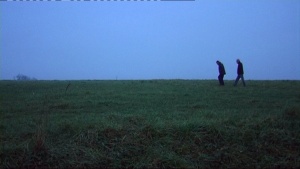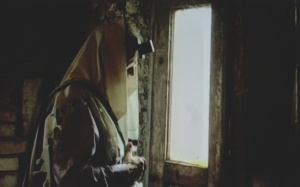Here I Learned to Love

What is your earliest memory? Itzik Weinberg’s earliest memory may be of him and his younger brother, Avner, fleeing the invading Germans in Cracow, Poland. At the same time their parents and grandparents were deported to the Belzec death camp. This moving documentary by Israeli filmmaker Avi Angel traces the search by these two brothers, now more than 70 years old, for the truth about their struggle for survival during the Holocaust under the constant care of three remarkable women.

“For decades Avner occasionally asked his brother Itzik; ‘How can I be certain we’re truly brothers?’” This outstanding film draws the viewer into their mutual search for identity and personal history that unfolds in a present haunted by a terrifying past. Carefully guided by the gentle prodding of the filmmaker the narrative that evolves as the brothers revisit each stage of their 4 year journey is deeply unnerving. Additionally it is thrown into sharp relief by the recent revelations in research at the United States Holocaust Memorial Museum that the actual extent of the Holocaust’s ghettos, extermination camps, slave labor camps and compulsory brothels was much more extensive than ever imagined. In light of this, their story becomes a paradigm of horror, dislocation and lifelong pain and doubt for millions of the Holocaust’s child survivors.
Since many of the locations still exist, the story progresses as they visit memorable scenes in their childhood wanderings. We first encounter them at the last stage of that journey, in a hotel in Montreux, Switzerland. The elegantly spare cinematography by Yuval Cohen and the elegiac music by Tami Barak immediately set the somber and introspective mood. Avner relates being told, “You’re a big boy now… God saved you from the concentration camp. He loves some people more than others… and Naomi, he loved her very, very much. And He took her…” “Suddenly there was no one…” That was how he found out that his “third mother” had died, just before he and his brother were finally taken to safety in Palestine. The 70 year old Avner feels orphaned yet again and weeps.
We return with them to Cracow, Poland, to the route they and thousands of other Jews marched to the infamous Podgorze ghetto. Avner, the 2 year old, was carried while the 3 year old Itzik walked. The brothers now watch historical films of the ghettoization of Cracow. This history is their history. Avner searches the National Archives; “looking from my real name, my family, my identity.” He finds his parents, just making out their names in the records and even views photographs that match his only photo of them. He has finally found his real mother whom he had lost when he was two.
Inside the ghetto apartment his older brother Itzik describes how it was divided up the last time they were together as a family. And outside, Itzik takes Avner’s hand and says, “run, run,” like we did to the bunker just across the street to escape. They go down into the dark, remembering how Aunt Malka hid them in the bunker right before the dreaded roundup. Avner says, “We were kids then, it seemed a game. We didn’t understand they wanted to kill us…” Their mother, Minda, told her sister Malka to take care of the boys, which she did, “like a lioness.”

Aunt Malka escaped with the boys into the Polish countryside to hide for “600 days…and wandered from farm to farm.” She gave them Christian names and put a cross around each child’s neck in order to pass. As if to ward off the memories of denying his Jewishness, Itzik now puts on tallis and tefillin and prays in a barn filled with animals, a painful reminder of their flight. They go into a Polish farmhouse and are treated to something they both remember as children: peasant bread spread with cream and garlic. The woman who makes it for them starts to cry, remembering that long ago her family saved Jews like them in this very house. Those were terrible years occasionally punctuated with acts of brave kindness. They remember Aunt Malka’s courage, how she lost a child in very difficult delivery in a stable and as a result remained childless her entire life; a woman devoted to children denied her own.
The movie continues to document how the boys and Malka miraculously were able to escape Poland into Hungary, only to be caught in the Nazi grip again. In one last courageous act, Malka tossed the boys on to a train everyone thought was going to Spain and then Palestine. It was the famous “Kastner Train” that had purchased the lives of 1670 Jews from Nazi controlled Budapest. From that momentous journey Avner comments that his childhood memories begin with the constant click-clack of the train. But it was not to be and instead they ended up in the Bergen Belsen concentration camp in which yet another heroic woman, Naomi Meyer, their third mother, ‘adopted” the brothers and managed their survival until the train’s passengers were released to Switzerland in December, 1944. This 20 year old woman nurtured the boys, taught them “everything, to write, to draw. Here I learned to love.” Itzik muses that “the foundations of my whole life were laid here. In this hell, we flourished again.” Finally towards the end of the movie they visit Naomi’s grave in Switzerland. Crushed by the death of her fiancée and the refusal of the authorities to allow her to adopt the brothers, she had committed suicide.
As these scenes from their past unfold in words, we see the brothers Avner and Itzik in modern Budapest, at the present sites of their youth. The world rushes around them, unaware that they are treading on a sacred history, one of personal as well as national Jewish suffering and survival. Young couples with their children stroll about in a normal and peaceful life seemingly unaware of their city’s terrible history. Later Avner and Itzik have a drink with the filmmaker Avi. They muse how each spent their lives differently; one ignoring his history, running from it, and the other pondering it in writings and memoirs. Now they look down and see they are holding each other’s hand, perhaps the first time since they held hands to run away from the Nazis. They have found each other again and they embrace. This is where Avi Angel’s sensitive film transcends the terrible facts of two brother’s lives and forces us to understand that in the journey to confront our past that we must all take someday, we must be able to reach out, acknowledge, forgive and hug our brethren.
Here I Learned to Love
A Documentary Produced and Edited by Avi Angel
Based on “Three Mothers for Two Brothers” by Izhak Weinberg
54 minutes: Quad Cinema March 1 – 7; soon on Amazon and iTunes